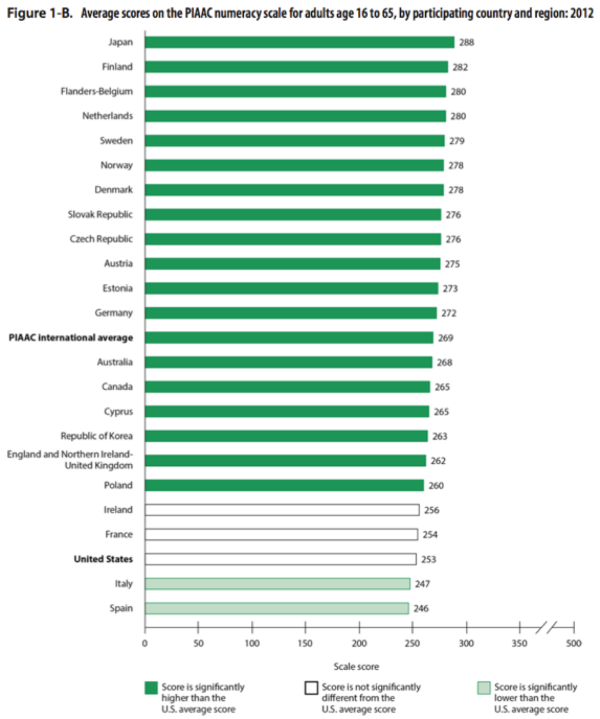Fewer than 12% of adults are competent at math
Nope, this isn’t a joke about writers’ math skills: Just 12% of adults around the world are numerically literate, according to an enormous global literacy study.

Which means that 88% of your audience members may find your bar charts, financial objectives and other communications involving numbers discombobulating.
Welcome to the world of numeracy, or numerical literacy, today, according to the 2013 Program for the International Assessment of Adult Competencies, or PIAAC.
Numeracy: the ability to understand and work with numbers.
PIAAC is an enormous, every-10-year literacy assessment, developed and organized by the Organization for Economic Cooperation and Development. The study seeks to determine how well adults in the age group 16-65 are prepared to function in today’s society.
Here’s how they stack up …
Just 12% of worldwide adults aged 16 to 65 are skilled at problem solving in mathResults of the 2013 PIAAC |
|||
| Proficiency levels | Worldwide adults 16+ | Adult skills | Sample task |
| Below level 1 Nonliterate 0-175 |
5% | Perform basic tasks: counting, arithmetic with whole numbers. | Review four price tags, which include the date packed, then indicate which item was packed first. |
| Level 1 Below basic 176-225 |
14% | Perform one-step tasks: count, sort, perform math, understand simple percentages (such as 50%). | Calculate how many layers of candles are in the box that says there are 105 candles in the box and shows there are five rows of seven candles. |
| Level 2 Basic 226-275 |
34% | Perform two or more calculations — simple measurements, spatial representations and estimates — and interpret simple tables and graphs. | Review a motor vehicle logbook with columns for dates of trip, odometer readings and distance traveled; then calculate trip expenses at 35 cents a mile plus $40 a day. |
| Level 3 Intermediate 276-325 |
35% | Understand and work with mathematical patterns, proportions and basic statistics expressed in verbal or numerical forms. | Review an illustration of a flattened box identifying its dimensions, then identify which of four pictures best represents the assembled box. |
| Level 4/5 Proficient 326-375 |
12% | 4: Perform analysis and complex reasoning; understand statistics and change and spatial relationships; communicate well-reasoned answers.
5: Understand complex abstract mathematical and statistical ideas embedded in complex tasks; draw inferences, arguments or models; justify, reflect on solutions or choices. |
Review two stacked-column bar graphs representing how many years of schooling men and women in Mexico have had by decade, then identify the percentage of men who had more than 6 years of schooling in 1970. |
How low can you go?
The results? Worldwide, adults weighed in at an average numeracy rate of 269 out of 500. That puts them at level 2, or below basic, numeracy skills.
Number crunching
Only nine countries, led by Japan, achieve even basic average numeracy rates

That means that, on average, these adults can figure out how many layers of candles are packed in a box of 105, with five rows of seven candles per layer. But they struggle to calculate trip expenses at 35 cents a mile plus $40 a day from a motor vehicle logbook with columns for date of trip, odometer readings and distance traveled.
How can you communicate numerical information in an environment where many people barely understand simple math?
___
Source: “Literacy, Numeracy, and Problem Solving in Technology-Rich Environments Among U.S. Adults: Results from the Program for the International Assessment of Adult Competencies 2012,” Program for the International Assessment of Adult Competencies, or PIAAC, National Center for Education Statistics

Leave a Reply